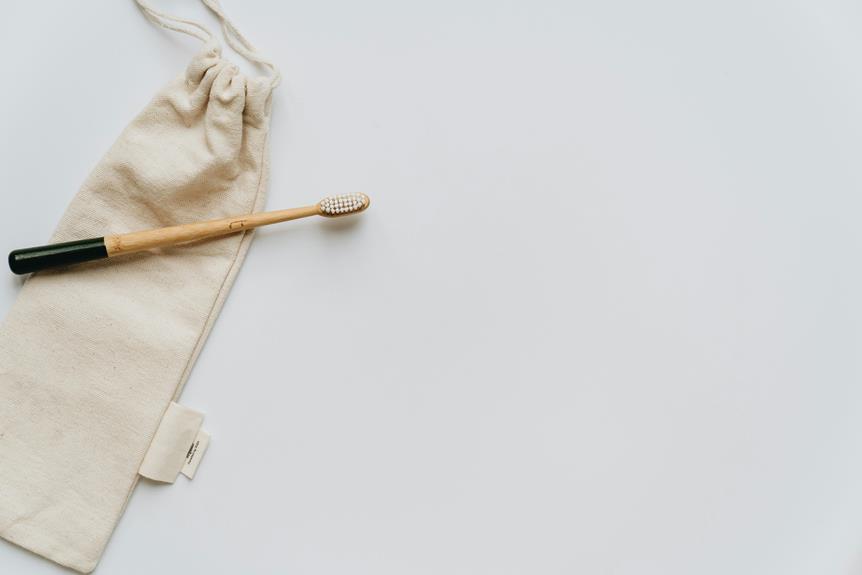When it comes to caring for bamboo fabric, you'll want to take a few essential steps to ensure its longevity and softness. Start by washing it in cold water on a gentle cycle with a mild detergent, and remember to turn your items inside out. Avoid bleach and fabric softeners, as they can harm the fibers. For drying, air drying is best, but if you choose a dryer, use low heat. These simple practices can keep your bamboo fabric looking great, but there's more to learn about maintaining its quality and avoiding common pitfalls.
Table of Contents
Key Takeaways
- Wash bamboo fabric in cold water using a gentle cycle and mild detergent to preserve its quality and fibers.
- Avoid bleach and fabric softeners, and always turn items inside out before washing.
- Air dry bamboo fabric in a shaded area to maintain color vibrancy and prevent shrinkage.
- If using a dryer, select low heat settings and remove items while still damp to minimize damage.
Understanding Bamboo Fabric
Bamboo fabric is a sustainable textile made from the pulp of bamboo plants, offering a soft, breathable alternative to traditional materials.
You'll appreciate its natural properties, as it's hypoallergenic, moisture-wicking, and resistant to odors. This makes it perfect for everyday wear, especially for sensitive skin.
When you touch bamboo fabric, you'll notice its silky texture, which feels luxurious against your skin. It's not only comfortable but also eco-friendly since bamboo grows quickly and requires minimal water and pesticides. By choosing bamboo, you're supporting sustainable practices and reducing your environmental footprint.
Bamboo fabric is versatile, used in everything from clothing to bed linens. However, it's essential to understand that its care differs from cotton or polyester. While the fabric is durable, taking the right approach will help maintain its qualities.
You'll find that bamboo's breathability and moisture-wicking properties keep you cool and dry, making it ideal for active wear and sleepwear.
As you learn to care for bamboo fabric, you'll ensure its longevity and keep it looking great. Understanding its unique qualities is the first step in enjoying this remarkable textile.
Pre-Washing Preparation
Before you wash your bamboo fabric, it's important to check the care label for specific instructions.
Make sure to sort your items by color to prevent any dye transfer during the wash.
Taking these steps will help keep your bamboo fabric looking its best.
Check Care Label
Checking the care label is essential for ensuring your bamboo fabric stays in top condition. The care label provides specific instructions tailored to your garment, which can help you avoid damaging it during washing. Always take a moment to read the label before you start any cleaning process.
Here's a quick reference to common care instructions you might find:
| Instruction | Meaning | Importance |
|---|---|---|
| Machine Wash | Use a washing machine on a gentle cycle | Reduces wear and tear on the fabric |
| Cold Water | Wash in cold water only | Prevents shrinkage and color fading |
| Do Not Bleach | Avoid bleach products | Preserves fabric integrity and color |
| Line Dry | Hang to dry instead of using a dryer | Prevents overheating and damage to fibers |
Sort by Color
Sorting your bamboo fabric items by color is crucial to prevent dye transfer and keep your garments looking vibrant. When you toss everything into one load, darker colors can bleed onto lighter ones, ruining your favorite pieces.
Start by grouping your items into three main categories: whites, darks, and colors. Whites should include all light-colored fabrics, while darks encompass blacks, navy, and deep jewel tones. Colors can include pastels and bright shades. By keeping these groups separate, you'll reduce the risk of discoloration.
Before washing, double-check for any tags or care instructions that might suggest specific washing methods for certain colors. If you notice any items that are particularly prone to color bleeding, consider washing them separately, even if they belong to the same category.
Additionally, it's a good idea to perform a quick color test on new items. Dampen a small corner and press it against a white cloth to see if any dye comes off. If it does, wash that item alone for the first few cycles.
This simple step will help maintain the beauty of your bamboo fabric for years to come.
Washing Instructions
To keep your bamboo fabric looking its best, wash it in cold water on a gentle cycle. This helps preserve the natural fibers and prevents shrinkage. Always use a mild detergent, as harsh chemicals can damage the fabric. Avoid bleach and fabric softeners, which can degrade the bamboo's quality over time.
When washing, it's a good idea to turn your bamboo items inside out. This protects the outer surface and helps maintain color vibrancy. If you're dealing with stubborn stains, treat them gently with a soft cloth or sponge and the mild detergent before washing.
Try to wash your bamboo fabric with similar colors to prevent any color bleeding. Overloading your washing machine can cause friction, so ensure there's enough space for your items to move freely.
If you're washing bamboo blends, keep in mind that the care instructions may differ slightly, so check the label.
Drying Techniques
When it comes to drying bamboo fabric, air drying is your best bet for maintaining its softness and durability.
You should definitely avoid high heat, as it can damage the fibers and lead to shrinkage.
Let's explore the benefits of air drying and how to do it effectively.
Air Drying Benefits
Air drying your bamboo fabric not only preserves its softness but also extends its lifespan by preventing damage from high heat. When you air dry, you allow the fabric to maintain its natural fibers without the risk of shrinkage or warping that can occur in a dryer. This method helps keep your bamboo garments looking fresh and new for longer.
Additionally, air drying is a more eco-friendly option. You're reducing energy consumption by skipping the dryer, which not only saves you money on your utility bill but also lowers your carbon footprint. Simply hang your bamboo fabric on a clothesline or a drying rack in a well-ventilated area.
By choosing to air dry, you also minimize the risk of fading, as direct sunlight can sometimes lead to discoloration. Instead, try to dry your items in the shade or indoors to maintain their vibrant colors.
Lastly, air drying gives you the opportunity to reshape your bamboo fabric while it dries. Lay flat or hang your clothing to maintain its intended shape, ensuring that it fits you perfectly when you wear it again.
Avoiding High Heat
High heat can damage bamboo fabric, so it's crucial to use gentle drying techniques to preserve its quality.
When it comes to drying your bamboo items, steer clear of high temperatures. Instead of tossing them in a hot dryer, consider air drying as your go-to method. Lay your bamboo fabric flat on a clean, dry surface or hang it up in a shaded area. This helps maintain its shape and softness.
If you absolutely need to use a dryer, opt for a low heat setting. However, always remove your bamboo items while they're still slightly damp—this minimizes the risk of shrinkage and keeps the fabric feeling luxurious.
You might also want to include dryer balls in the mix; they can help separate the fabric and reduce drying time without subjecting it to intense heat.
Ironing and Storage
Iron bamboo fabric at a low temperature to smooth out wrinkles without damaging its fibers.
Use a steam iron or a pressing cloth to protect the fabric's surface. When you're ironing, move the iron gently over the fabric, avoiding any harsh pressure. This way, you'll keep the bamboo looking fresh and vibrant.
Once your bamboo fabric is wrinkle-free, proper storage is key to maintaining its quality. Always store it in a cool, dry place, away from direct sunlight, which can cause fading. If you're storing bamboo clothing, fold it neatly to avoid creases. Avoid hanging it for long periods, as this can stretch the fabric.
For bamboo sheets or towels, consider using breathable storage bags or cotton bins to keep them dust-free while allowing air circulation. Ensure the items are completely dry before putting them away to prevent mildew.
If you want to keep bamboo fabric looking its best, take a moment to check on it occasionally, especially if it's been stored for a while. By following these simple ironing and storage tips, you'll help extend the life of your bamboo fabric items.
Troubleshooting Common Issues
Even with proper care, bamboo fabric can sometimes present issues that need addressing. One common problem is pilling. If you notice small balls of fabric forming, it usually means the fabric is rubbing against something. To fix this, gently use a fabric shaver or a lint roller to remove the pills.
Another issue is color fading. If your bamboo fabric has lost its vibrancy, it might be due to washing it in hot water or exposing it to direct sunlight. Always wash in cold water and dry in the shade to maintain the color.
You might also encounter odors, especially if the fabric has been stored for a while. To eliminate smells, air out the fabric in a well-ventilated area, or wash it with a gentle detergent.
Frequently Asked Questions
Can Bamboo Fabric Shrink After Washing?
Yes, bamboo fabric can shrink after washing, especially if you use hot water or high heat in the dryer. To prevent this, wash in cold water and air dry or use a low heat setting.
Is Bamboo Fabric Hypoallergenic?
Yes, bamboo fabric's hypoallergenic properties make it great for sensitive skin. It resists dust mites and allergens, so you can wear it comfortably without worrying about irritation or allergic reactions. You'll appreciate its softness and breathability.
Does Bamboo Fabric Require Special Detergents?
Bamboo fabric doesn't require special detergents. You can use your regular gentle detergent, but avoid harsh chemicals and bleach. This way, you'll keep the fabric soft and preserve its natural qualities for longer.
Can I Bleach Bamboo Fabric?
You shouldn't bleach bamboo fabric, as it can weaken the fibers and cause discoloration. Instead, opt for gentle cleaning methods to maintain its softness and durability, keeping your bamboo items looking fresh and vibrant.
How Does Bamboo Fabric Compare to Cotton in Durability?
Bamboo fabric often outlasts cotton due to its natural strength and resistance to wear. You'll find it less prone to fraying, fading, or stretching, making it a durable choice for your clothing and textiles.
- How Does Ring Spun Cotton Affect Garment Fit and Shape Retention? - August 13, 2024
- What Are the Challenges in Producing Ring Spun Cotton? - August 13, 2024
- Is Ring Spun Cotton Suitable for Plus-Size Clothing? - August 13, 2024




